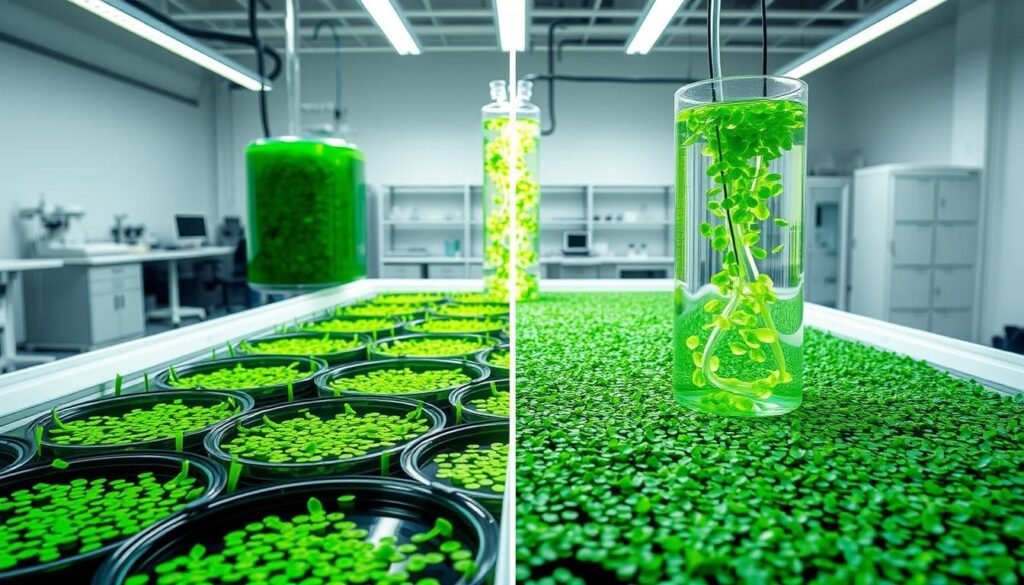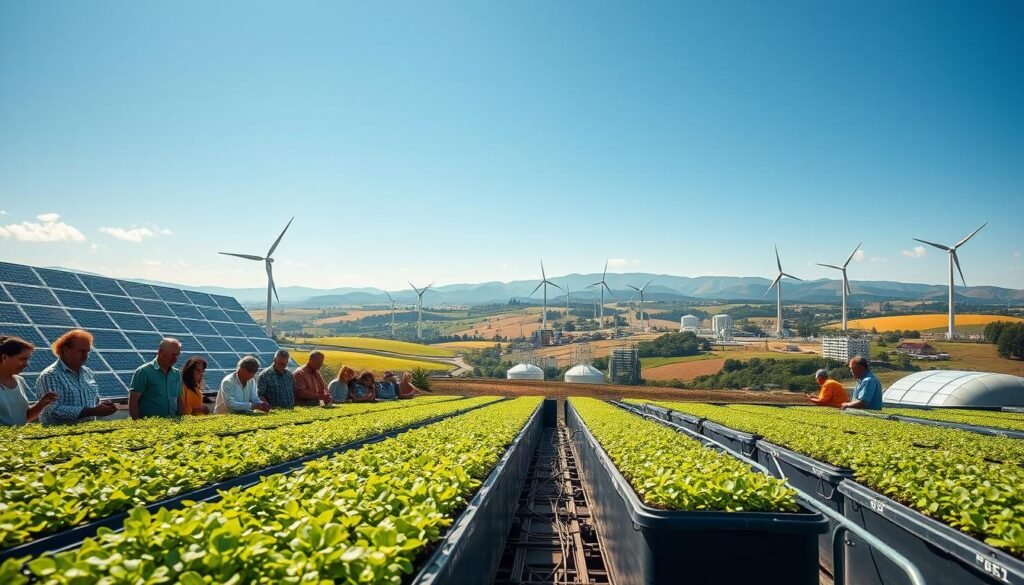Imagine tiny green organisms holding the key to cleaner power. That’s exactly what algae offer for our planet’s future. These remarkable plants convert sunlight and carbon dioxide into valuable biomass through natural photosynthesis.
Microalgae stand out as particularly efficient energy producers. They grow rapidly and don’t compete with food crops for land. This makes them an exciting alternative to traditional fossil fuels.
Current research focuses on improving cultivation methods and boosting lipid production. Scientists are developing advanced systems that capture CO2 while generating sustainable energy. The potential for reducing greenhouse gas emissions is tremendous.
Though challenges remain in scaling up production and cutting costs, progress continues. Genetic engineering and new technologies are making algae biofuels more viable every day. Your energy future might just be greener than you think.
Key Takeaways
- Algae convert sunlight and CO2 into biomass through natural photosynthesis
- Microalgae offer high growth rates without competing for agricultural land
- Algae-based biofuels can significantly reduce greenhouse gas emissions
- Current research focuses on improving cultivation efficiency and lipid production
- Algae systems can capture carbon while producing sustainable energy
- Genetic engineering is enhancing algae’s potential as a renewable energy source
- Scaling production and reducing costs remain key challenges for widespread adoption
Why Algae Biofuels Matter for Your Energy Future
Your future energy security might depend on microscopic green powerhouses. These tiny organisms offer a path away from traditional petroleum sources that harm our planet.
Algae biofuels significantly cut carbon emissions that drive climate change. They represent a clean alternative to conventional diesel and gasoline.
Unlike corn or soybean biofuels, algae cultivation doesn’t compete with food crops. You get sustainable energy without affecting global food supplies or requiring farmland.
These systems use minimal water and can grow in harsh conditions. Many species thrive in wastewater or salty environments unsuitable for agriculture.
The economic picture keeps improving as technology advances. Production costs are becoming competitive with conventional fossil fuels while delivering superior environmental benefits.
During growth, algae actively capture CO2 from the atmosphere. This natural process helps combat global warming while creating valuable biomass for fuel generation.
Researchers continue developing better cultivation methods and harvesting techniques. These improvements address challenges like low biomass concentration and processing expenses.
Global investment in algae biofuel research shows strong commitment to this energy source. Countries worldwide recognize its potential for sustainable power generation.
Your support for this development leads to cleaner communities and energy independence. These fuels are biodegradable, non-toxic, and produce fewer emissions than petroleum alternatives.
Understanding Biofuel Generations: From Crops to Algae
Different biofuel generations represent significant leaps in sustainable energy development. Each new wave addresses limitations from previous approaches. This evolution brings us closer to truly clean energy sources.
You’ll discover how technology has progressed through four distinct phases. Early biofuels faced serious environmental and ethical challenges. Modern solutions like microalgae offer exciting alternatives to fossil fuels.
First-Generation Biofuels: Food vs. Fuel Debate
First-generation biofuels come from food crops like soybean and palm oil. These sources sparked intense debates about food security versus fuel production. Using edible plants for energy created global market disruptions.
Major issues included water scarcity and deforestation impacts. Converting farmland for fuel production reduced food supplies. This approach proved unsustainable despite its initial promise.
Environmental costs often outweighed the benefits of reduced emissions. The food versus fuel controversy limited widespread adoption. Researchers quickly sought better alternatives for biofuel production.
Second-Generation Biofuels: Non-Food Alternatives
Second-generation biofuels use non-edible sources like Jatropha plants. Lignocellulosic biomass from agricultural waste also became popular. These options avoided direct competition with food supplies.
However, significant challenges remained with land requirements. Huge areas were still needed for cultivation and growth. Technological efficiency limitations kept costs high.
Processing methods for these complex materials proved difficult. Harvesting and conversion processes required substantial energy inputs. While better than first-generation, these biofuels still had drawbacks.
Third and Fourth Generations: Why Algae Stands Out
Third-generation biofuels from microalgae changed everything. These tiny organisms avoid previous generation issues completely. They don’t compete for agricultural land or freshwater resources.
Microalgae offer astonishing oil yields compared to traditional crops. Some species produce up to 80% oil content by weight. This far exceeds oil palm’s 36% or maize’s 44% maximum.
Productivity measurements show incredible potential. Microalgae can yield 136,900 liters per hectare annually. Oil palm manages only 5,366 liters in the same area.
Fourth-generation takes this further with genetic engineering. Scientists enhance lipid production through advanced modification. This pushes the boundaries of what’s possible in renewable energy.
Environmental advantages make algae biofuels particularly attractive. They grow on non-arable land using waste CO2 from industrial processes. Species like Botryococcus braunii and Chlorella lead with high lipid content.
Ongoing research continuously improves efficiency and reduces cost. These developments make algae biofuels more viable against fossil fuels. The future of sustainable energy looks brighter with these advancements.
How Algae Converts Sunlight into Renewable Energy
You’re about to discover how microscopic organisms perform energy miracles using nothing but sunlight and air. These tiny powerhouses use natural photosynthesis to create valuable biomass. This process forms the foundation of sustainable energy production.
Microalgae excel at capturing carbon dioxide from various sources. They absorb CO2 from the atmosphere or industrial emissions. This dual action reduces greenhouse gas while generating clean fuel.
Special pigments like chlorophyll help microalgae absorb light efficiently. They utilize a broad spectrum of solar radiation for optimal growth. This natural light harvesting maximizes their energy potential.
Several factors influence photosynthesis effectiveness in these systems. Light intensity directly affects biomass production rates. Temperature and nutrient levels also play crucial roles in lipid accumulation.
Microalgae demonstrate remarkable photosynthetic efficiency compared to traditional crops. They yield significantly more energy per unit area than agricultural alternatives. This makes them superior for biomass production.
Artificial lighting systems sometimes supplement natural sunlight in cultivation. These technologies maintain consistent growth conditions year-round. However, they can increase operational costs for large-scale production.
Integration with carbon capture technologies represents an exciting development. Microalgae systems can serve dual purposes for climate mitigation and energy generation. This combination addresses multiple environmental challenges simultaneously.
Researchers use various methods to measure photosynthetic performance. Oxygen production monitoring and chlorophyll fluorescence analysis provide valuable data. These techniques help optimize cultivation conditions for maximum output.
It’s amazing how simple sunlight transforms into renewable fuels through these processes. Your daily energy needs could someday be met by these natural conversion systems. The potential for clean, sustainable power generation continues to grow.
Ongoing research focuses on enhancing natural photosynthesis through multiple approaches. Genetic engineering and optimized cultivation methods show promising results. These developments could revolutionize how we produce biofuels in the future.
Key Microalgae Species Powering Biofuel Production
Meet the tiny powerhouses driving sustainable fuel innovation. These remarkable organisms offer incredible diversity for energy solutions. Their unique properties make them perfect for biofuel applications.
High-Lipid Producers: Chlorella and Botryococcus Braunii
Chlorella stands out as a research favorite for good reason. This green microalgae achieves up to 50% lipid content. Its rapid growth makes it ideal for biomass production.
Botryococcus braunii takes oil production to another level entirely. This species can reach an astonishing 80% oil content. That makes it one of nature’s most efficient fuel sources.
Both species demonstrate excellent carbon capture capabilities. They absorb CO2 while creating valuable biomass. This dual action supports cleaner energy generation.
Adaptable Species for Large-Scale Production
Nannochloropsis offers impressive hydrocarbon production potential. It thrives in various saltwater environments. This adaptability simplifies cultivation systems.
Dunaliella handles extreme salinity with remarkable ease. It grows where other species would struggle. This toughness reduces water requirements.
Crypthecodinium cohnii specializes in lipid accumulation. It produces high-quality oils for fuel conversion. Researchers value its consistent performance.
These species excel under challenging conditions. Many tolerate high CO2 concentrations or temperature fluctuations. Their resilience supports scalable production methods.
Genetic diversity provides numerous options for different environments. Scientists continuously screen new strains for improved characteristics. This work enhances biofuel potential.
Ongoing development focuses on stress resistance and lipid accumulation. Genetic engineering pushes boundaries for better fuel sources. These advances address cost challenges.
Many species produce valuable co-products alongside biofuels. Carotenoids and polysaccharides have commercial applications. This adds economic value to the cultivation process.
Your energy future benefits from this incredible natural diversity. These tiny organisms pack massive potential for sustainable fuels. Their versatility promises exciting developments ahead.
Algae Cultivation Systems: Open Ponds vs. Photobioreactors
Your journey into sustainable fuel production begins with choosing the right growing environment. Two main approaches dominate this field, each with distinct advantages and limitations. Understanding these systems helps you appreciate the engineering behind clean energy.

Raceway Ponds: Low-Cost but Challenging
Raceway ponds represent the most common open cultivation method. These shallow, oval-shaped channels use paddle wheels to circulate water. This simple design keeps construction costs remarkably low.
However, open systems face significant contamination risks. Predators and competing species can easily invade these exposed environments. Weather conditions also create unpredictable growth patterns.
Temperature fluctuations and evaporation present additional challenges. These factors can dramatically affect productivity and consistency. Despite these issues, raceways remain popular for large-scale applications.
Photobioreactors: Controlled Environment Advantages
Photobioreactors offer completely enclosed growing conditions. These systems use transparent tubes or panels to contain the culture. This sealed environment prevents contamination from external sources.
You get precise control over light exposure and CO2 levels. Temperature management becomes much more consistent and reliable. These optimized conditions yield higher biomass density and quality.
The main drawback involves substantially higher capital investment. Complex engineering and materials increase upfront costs significantly. However, operational expenses often prove lower than open systems.
Hybrid Systems: Combining the Best of Both Worlds
Hybrid approaches leverage strengths from both cultivation methods. Photobioreactors typically produce clean, high-quality inoculum. This starter culture then transfers to open ponds for bulk growth.
This combination maximizes cost efficiency and productivity. You maintain contamination control during critical early stages. Then you scale up using more economical raceway systems.
Ongoing research continues refining these integrated approaches. New technologies aim to further reduce production costs. The goal remains making biofuels commercially competitive.
Your choice depends on specific species requirements and local conditions. Each system offers unique benefits for different applications. The right selection maximizes both economic and environmental returns.
Optimizing Algae Growth for Maximum Biomass
You control the dials for maximum algae productivity. Getting the most from these tiny powerhouses requires careful attention to multiple factors. Your success depends on balancing growth speed with lipid accumulation.
Optimal conditions vary between different species and cultivation systems. What works for one setup might not suit another. This makes understanding basic principles essential for your operation.
Nutrient Management: Nitrogen and Phosphorus Effects
Nitrogen availability directly impacts your biomass production. Limited nitrogen can actually boost lipid content in many species. However, this often comes at the cost of reduced growth rates.
Phosphorus plays equally important roles in cellular processes. Both nutrients require careful monitoring and adjustment. You need to find the sweet spot for your specific goals.
Smart nutrient management represents a key efficiency challenge. The right balance maximizes both quantity and quality. This optimization process continues evolving through ongoing research.
Carbon Source Utilization: CO2 and Bicarbonate
Carbon dioxide remains essential for photosynthesis in your cultivation systems. Optimal concentrations typically range between 1-5% for most species. Higher levels can sometimes inhibit growth rather than help it.
Industrial flue gas offers an excellent low-cost carbon source. This approach turns waste emissions into valuable biomass. It’s a brilliant example of circular economy applications.
Sodium bicarbonate (NaHCO3) provides an alternative carbon delivery method. Many find bicarbonate easier to handle than gaseous CO2. It can also stimulate lipid synthesis under certain conditions.
Environmental Factors: Light, Temperature and Salinity
Light intensity directly drives your photosynthetic efficiency. Too little light limits growth, while too much can cause damage. Finding the right balance requires careful monitoring.
Temperature affects metabolic processes and growth rates. Most species prefer specific ranges for optimal performance. Going outside these ranges reduces productivity significantly.
Salinity levels influence osmotic pressure and cellular function. Some species tolerate wide variations, while others need precise control. Your water source quality directly impacts this factor.
Environmental management technologies continue improving through research. Automated systems now maintain ideal conditions with minimal effort. These developments address key production challenges.
Genetic analysis helps understand how species respond to different conditions. This knowledge drives better cultivation methods and higher yields. Your optimization efforts benefit from these ongoing advancements.
The Production Process: From Algae to Biofuel
You’re witnessing a remarkable transformation where microscopic organisms become clean fuel. This journey involves two distinct phases working together seamlessly. Each step contributes to creating sustainable energy sources for your future needs.
Upstream Processes: Cultivation and Growth Optimization
Everything begins with careful cultivation under controlled conditions. You maximize biomass through precise environmental management. Light intensity, temperature, and nutrient levels all require constant monitoring.
Carbon dioxide delivery systems feed these hungry microorganisms. Many operations use industrial emissions as their primary CO2 source. This clever approach turns waste gas into valuable biomass.
Growth optimization focuses on achieving the highest possible yields. Researchers constantly test new cultivation methods and techniques. Their work improves efficiency while reducing operational costs.
Downstream Processes: Harvesting and Oil Extraction
Harvesting presents significant challenges in production systems. Concentrating dilute algal cultures demands substantial energy inputs. Common methods include:
- Centrifugation: Spinning cultures at high speeds
- Flocculation: Using chemicals to clump cells together
- Filtration: Passing cultures through fine membranes
Drying prepares biomass for oil extraction processes. This step accounts for nearly one-third of total production expenses. Innovative approaches use waste heat to reduce energy consumption.
Oil extraction employs various techniques with different advantages. Solvent methods offer high efficiency but involve chemical handling. Mechanical pressing provides cleaner operation with lower yields.
Enzymatic extraction represents emerging technology in this field. Biological catalysts break down cell walls gently and efficiently. This method shows promise for reducing environmental impact.
Final conversion creates usable fuels through established processes. Transesterification transforms oils into biodiesel suitable for engines. Fermentation produces bioethanol from carbohydrate-rich biomass.
Ongoing research addresses cost reduction throughout these steps. Scientists develop integrated approaches that improve overall efficiency. Their work makes biofuels more competitive with conventional fuels.
You benefit from these advancements through cleaner energy options. Each improvement brings sustainable fuels closer to widespread availability. The future looks brighter thanks to these dedicated efforts.
Economic Viability of Algae Biofuel Production
You might wonder about the real-world economics behind these green energy solutions. Making biofuels commercially viable requires overcoming significant financial hurdles. Current production costs remain higher than traditional petroleum sources.
Several factors contribute to these expense challenges. Capital investments for advanced cultivation systems can be substantial. Operational costs for maintenance and energy inputs add to the financial burden.
Current Cost Challenges and Solutions
Photobioreactors represent a major investment in your production setup. These closed systems offer better control but come with higher upfront costs. Harvesting and extraction processes also account for significant expenses.
Innovative approaches are addressing these financial barriers. Using waste CO2 from industrial emissions cuts input costs dramatically. Wastewater nutrients provide another cost-saving opportunity.
Genetic engineering enhances lipid production in various species. This improves yield per cultivation cycle. Better strains mean more fuel from the same resources.
Integrated biorefineries create multiple revenue streams. Besides biofuels, you can produce:
- Nutraceuticals and food supplements
- Animal feed and agricultural products
- Cosmetics and pharmaceutical ingredients
Comparing Production Costs with Fossil Fuels
Traditional petroleum currently holds a price advantage. Market prices for crude oil fluctuate but generally remain lower. This makes competition challenging for newer technologies.
However, hidden costs change this comparison significantly. Fossil fuels carry environmental expenses that aren’t reflected in their price. Carbon emissions and pollution create societal burdens.
Government policies help level the playing field. Tax incentives and research grants support development. Renewable energy standards create market opportunities.
Economies of scale will continue driving costs downward. Larger production facilities spread fixed costs across more output. Technological improvements enhance efficiency throughout the process.
Your support for this emerging industry matters today. Investment in research and development accelerates progress. Each innovation brings us closer to cost-competitive biofuels.
The long-term outlook remains promising despite current challenges. Sustainable energy independence justifies continued development. Environmental benefits add value beyond simple price comparisons.
Environmental Benefits of Algae-Based Energy
Nature’s smallest carbon warriors offer big environmental solutions. These tiny organisms deliver multiple ecological advantages while creating clean power. You get sustainable energy without harming ecosystems.
Microalgae systems work like natural air purifiers. They absorb carbon dioxide while producing valuable biomass. This dual action makes them climate champions.
Carbon Capture and Climate Change Mitigation
Your algae cultivation actively fights global warming. These systems capture CO2 during their growth process. Some facilities use industrial emissions as feedstock.
Life cycle analysis shows impressive results. Algae biofuels have lower carbon footprints than fossil fuels. From production to consumption, they emit fewer greenhouse gases.
Consider these climate benefits:
- Active carbon sequestration during growth phases
- Reduced net emissions compared to petroleum fuels
- Utilization of waste CO2 from industrial sources
- Closed carbon cycle through sustainable practices
Water and Land Use Advantages
You save precious resources with this approach. Microalgae need minimal land for cultivation. They thrive on non-arable land and desert areas.
Water efficiency stands out as a major advantage. These systems can use:
- Saline or brackish water sources
- Wastewater from treatment facilities
- Industrial process water streams
This approach avoids agricultural land competition. You get biomass production without affecting food security. Habitat preservation becomes an automatic benefit.
Bioremediation represents another valuable application. Microalgae clean polluted water through natural processes. They absorb nutrients and contaminants while growing.
Your support drives circular economy development. Waste streams transform into valuable energy products. Environmental restoration happens alongside fuel production.
Future generations inherit a healthier planet. These technologies offer sustainable paths forward. You contribute to ecological balance with every gallon produced.
Genetic Engineering Advances in Algae Biofuels
Science is rewriting nature’s code for better energy solutions. Genetic tools now enhance what microalgae naturally do best. These advancements push biofuel potential to exciting new levels.
You get improved strains through precise genetic modifications. Researchers target specific genes controlling lipid production. This approach boosts oil yields significantly.
Enhancing Lipid Production Through Genetic Modification
Scientists focus on metabolic pathways for better results. Overexpression techniques increase enzyme activity in lipid synthesis. Knocking out competing pathways directs more carbon toward oil production.
Omics technologies provide valuable insights for improvement. Genomics identifies key genes responsible for high yields. Transcriptomics reveals how genes express under different conditions.
CRISPR technology offers unprecedented editing precision. This tool modifies microalgae genomes with remarkable accuracy. It creates custom strains optimized for biofuel applications.
Engineered species handle stress conditions more effectively. Some tolerate higher CO2 concentrations from industrial sources. Others thrive in saline environments using minimal freshwater.
Risk Assessment and Safety Considerations
Environmental release concerns require careful management. Containment strategies prevent modified strains from escaping. Physical barriers and biological controls work together.
Regulatory frameworks ensure thorough safety analysis. Agencies evaluate potential ecosystem impacts before approval. Strict protocols govern research and commercial use.
Public perception presents additional challenges for adoption. Transparent communication builds trust in new technologies. Ethical considerations guide responsible innovation.
Ongoing research balances progress with precaution. Scientists develop fail-safe mechanisms for added security. These measures protect natural ecosystems while advancing biofuel development.
Your energy future benefits from these careful approaches. Genetic engineering makes biofuels more viable every day. Responsible innovation ensures sustainable progress for everyone.
Artificial Photosynthesis: Mimicking Nature’s Design
You’re looking at technology that copies nature’s brilliant energy blueprint. Artificial photosynthesis creates fuels directly from sunlight, water, and carbon dioxide. This approach mirrors what plants and microalgae do naturally.
These systems use semiconductors instead of chlorophyll. Materials like titanium dioxide capture light energy. They then drive chemical reactions that produce hydrogen or hydrocarbons.
How Artificial Systems Compare to Natural Algae Processes
Both approaches convert solar energy into storable fuels. Natural systems use living organisms that grow and reproduce. Artificial versions rely on engineered materials and precise engineering.
Key differences emerge in control and scalability. You can tune artificial systems for specific outputs. Biological processes offer self-repair and adaptation capabilities.
Light absorption efficiency varies between these methods. Some artificial setups achieve higher conversion rates. Natural systems excel at utilizing broad light spectra.
Consider these comparative advantages:
- Artificial systems: Precise control over fuel output
- Natural processes: Self-replication and low maintenance
- Hybrid approaches: Combining both strengths
Current Limitations and Future Potential
Several hurdles remain for widespread adoption. Efficiency levels need improvement for commercial viability. Material costs present significant economic challenges.
Stability under operational conditions requires enhancement. Catalyst degradation reduces long-term performance. Researchers address these issues through innovative designs.
Recent advancements show promising directions. New catalyst materials improve reaction rates. System designs enhance light capture and utilization.
Future applications could include decentralized energy production. Imagine artificial leaves generating fuel anywhere. These technologies complement existing renewable options.
Hybrid systems represent particularly exciting possibilities. Combining artificial components with biological processes. This integration could maximize overall energy conversion.
Your energy future might include these innovative solutions. They offer additional pathways beyond traditional approaches. Continued research drives progress toward practical applications.
Global Market Trends in Algae Biofuels
You’re watching a worldwide energy transformation unfold. Nations are racing to develop sustainable fuel sources. Algae-based options are gaining serious momentum across global markets.
Market analysis shows impressive growth patterns. Investment flows into research and pilot projects. Traditional energy companies are joining innovative startups.
Leading Countries in Algae Biofuel Research and Production
The United States leads in both research and development. Major programs receive substantial government funding. Private sector involvement continues expanding rapidly.
China invests heavily in this emerging technology. Their focus addresses pollution and energy security. Large-scale cultivation systems show promising results.
European Union countries prioritize sustainable energy solutions. Germany and the Netherlands host advanced research facilities. Their approach combines environmental goals with economic development.
Brazil leverages its bioethanol experience. They’re adapting existing infrastructure for new applications. This diversification strengthens their renewable energy portfolio.
India emerges as another key player. Their tropical climate favors year-round cultivation. Government initiatives support both research and commercial production.
Market Growth Projections and Investment Trends
Market studies predict significant expansion ahead. As technologies mature, costs continue decreasing. This improves commercial viability against fossil fuels.
Global bioethanol production doubled between 2007-2017. This growth demonstrates renewable energy’s potential. Algae-based fuels follow similar upward trajectories.
Investment comes from multiple sources:
- Government grants supporting basic research
- Private ventures funding pilot projects
- International collaborations sharing knowledge
- Corporate partnerships scaling production
Policy incentives drive adoption forward. Carbon taxes and renewable fuel standards create markets. These measures encourage investment in cleaner alternatives.
Key industry players range from small startups to energy giants. Some focus on innovative cultivation methods. Others develop efficient processing technologies.
Emerging economies address multiple challenges simultaneously. They seek energy independence while reducing pollution. Their investments reflect these dual priorities.
Market penetration faces natural hurdles. Competition exists from other renewable sources. Commercial success stories will accelerate adoption.
Your awareness influences this evolving landscape. Consumer support drives market dynamics. Together, we’re building a sustainable energy future.
Overcoming Technical Challenges in Commercial Production
Technical hurdles stand between current research and your future fuel. Making biofuels commercially viable requires solving complex production puzzles. These challenges span from cultivation to final processing.
Low biomass concentration presents a major obstacle. Harvesting becomes energy-intensive when dealing with dilute cultures. This increases overall production costs significantly.
Improving Harvesting and Processing Efficiency
Innovations in harvesting technology are reducing costs dramatically. Improved centrifugation systems now handle larger volumes with less energy. Flocculation methods use natural compounds to clump cells together.
Filtration technologies have advanced considerably. New membrane materials offer better separation with lower maintenance. These developments address key efficiency challenges.
Downstream processing receives equal attention. Enzymatic extraction methods show great promise for gentle cell breakdown. Supercritical fluid techniques offer clean alternatives to solvent-based approaches.
Consider these emerging solutions:
- Advanced centrifugation with energy recovery systems
- Bio-based flocculants from sustainable sources
- Smart filtration with automated cleaning cycles
- Enzymatic pretreatment for easier oil release
- Supercritical CO2 extraction for pure products
Scaling Up from Laboratory to Industrial Production
Moving from lab experiments to commercial scale involves multiple hurdles. Maintaining strain purity becomes challenging in large systems. Growth conditions must remain consistent across expanded operations.
Photobioreactor designs are optimizing for larger applications. Engineers focus on better mixing and light distribution. Gas exchange systems handle increased CO2 demands efficiently.
Automation plays a crucial role in scaling success. Monitoring systems track key parameters in real-time. This ensures consistent production quality and maximum yield.
Integrated approaches improve overall economics. Combining cultivation with wastewater treatment creates dual benefits. Using industrial emissions as CO2 sources reduces input costs.
Overcoming these challenges requires multidisciplinary collaboration. Biologists work with engineers and economists. Together they develop solutions that address all aspects of production.
Continued research and pilot projects bring us closer to success. Each innovation makes biofuels more accessible. Your energy future looks brighter with every breakthrough.
The Future of Algae in Renewable Energy
Tomorrow’s energy landscape is being shaped by today’s innovations. You’re about to explore exciting developments that could transform how we power our world. These advancements promise cleaner fuels and smarter energy systems.
Emerging Technologies and Research Directions
Cutting-edge science is pushing boundaries in biofuel production. Synthetic biology creates custom microalgae strains with enhanced capabilities. These engineered organisms produce more lipids while growing faster.
Artificial intelligence optimizes cultivation conditions in real-time. Smart sensors monitor water quality, light exposure, and nutrient levels. Automated systems adjust parameters for maximum biomass production.
Digital twins create virtual models of entire operations. You can test new methods without risking actual production. This approach reduces development time and costs significantly.
Advanced photobioreactors incorporate innovative materials. Some use nanotechnology for better light distribution. Others feature self-cleaning surfaces that maintain efficiency.
Research focuses on multiple improvement areas:
- Enhanced lipid yields through genetic modification
- Reduced production costs across entire value chains
- Improved sustainability through waste utilization
- Better integration with existing energy infrastructure
Integration with Existing Energy Infrastructure
Algae systems complement current power generation beautifully. Many facilities can capture carbon emissions from industrial plants. This turns pollution into valuable biomass for fuel production.
Your existing vehicles might already run on algae blends. These biofuels work in standard engines with minimal modifications. Some blends require no changes at all.
Hybrid energy systems combine multiple renewable sources. Algae cultivation pairs perfectly with solar and wind installations. This creates more reliable and efficient energy generation.
Power plants can implement co-production strategies. They generate electricity while cultivating microalgae using waste heat and CO2. This approach maximizes resource utilization.
Future applications extend beyond transportation fuels. Algae-based bioplastics offer sustainable packaging solutions. Animal feed and nutritional products create additional revenue streams.
Policy support accelerates technology adoption. Public-private partnerships fund research and demonstration projects. Government incentives help scale promising technologies.
Imagine decentralized energy production through local algae farms. These facilities could serve communities while reducing transportation needs. Your energy future might be both local and sustainable.
The potential for emission reduction remains tremendous. Widespread adoption could significantly cut carbon output. Energy security improves through domestic production capabilities.
Continued research addresses remaining challenges. Cost reduction and efficiency improvements drive commercial viability. Each breakthrough brings us closer to practical implementation.
Your awareness and support matter greatly. Consumer interest encourages further investment and development. Together, we’re building a cleaner energy future.
How You Can Support Algae Biofuel Development
Your personal actions can accelerate the growth of sustainable fuel technologies. Every choice you make contributes to cleaner energy solutions for our future.
Advocating for supportive policies makes a real difference. Contact your representatives about renewable energy incentives. Vote for measures that fund research into advanced biofuels.
Staying informed helps you make better decisions. Follow scientific journals and industry publications. Attend webinars about microalgae applications in energy production.

Investment opportunities exist for forward-thinking supporters. Consider green energy funds that include biofuel companies. Some platforms offer direct investment in promising startups.
Your consumer choices drive market demand. Look for brands using algae-based products. Support companies investing in sustainable energy technologies.
Education spreads awareness about this important technology. Share what you’ve learned with friends and family. Help others understand the potential of microalgae fuels.
Hands-on participation brings the science to life. Join citizen science projects involving cultivation. Community initiatives often welcome enthusiastic volunteers.
Small daily actions create collective impact. Reduce your personal carbon footprint. Choose sustainable transportation options when possible.
Your support accelerates technology development. Every voice matters in the transition to cleaner fuels. Together, we can overcome current challenges.
Remember that your involvement makes a difference. The future of energy production depends on today’s choices. You’re helping build a more sustainable world.
Conclusion: The Path Forward for Algae Renewable Energy
Microalgae biofuels represent a promising sustainable energy source. They capture carbon while growing and require minimal land or freshwater. These benefits make them a valuable part of our energy future.
Current challenges involve scaling production and reducing costs. Advancements in genetic engineering and cultivation methods address these issues. Continued research and investment accelerate progress.
Your support drives innovation in this exciting field. Algae biofuels complement other renewable sources, creating a diverse energy portfolio. Global collaboration shares knowledge and resources.
Every step forward brings us closer to cleaner energy solutions. Together, we build a sustainable world powered by nature’s tiny powerhouses.






